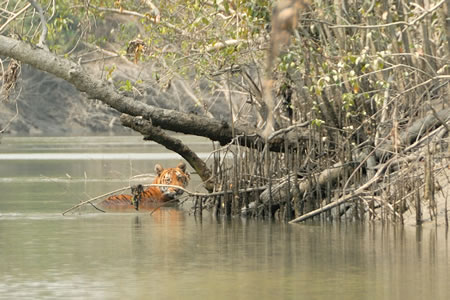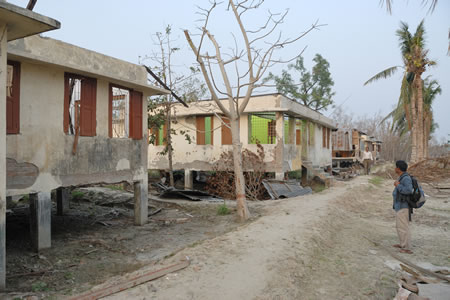

| Sundarbans, world’s largest mangrove forest | |
Khulna (Bangladesh), March 8th 2008 |
|
Long before we arrived in Bangladesh, we did already some reading about what to see and expect in this country. One of the conclusions we made was that the Bangladeshi Sundarbans would probably be one of the highlights of our visit. And yes, it was! However, you need to have some luck regarding the wildlife that you will see, but there are also some aspects that you act on. When we arrived in Bangladesh, in February 2008, we were not sure yet if it was possible and worthwhile to bring a visit to the Sundarbans. Cyclone Sidr hit southern Bangladesh just three months earlier (on November 15th 2007) and devastated big parts of southern Bangladesh. More than 6000 people lost their lives. The mangrove forest of Sundarbans was also hit badly by Sidr. What the exact damage is, is still not completely known. On the internet and in the local media you can see many pictures about the damage caused by Sidr, but specialist are not sure yet what the impact of Sidr is on the wildlife population. Some people estimate that 30-50% of the wildlife is killed while other people think that the damage is not that bad. Eventually, we decided to bring a visit to Sundarbans and see what is still left of this unique forest. |
|
 |
|
An encounter with a wild tiger! |
|
There are different ways to bring a visit to Sundarbans. Many Bangladeshi people decide to visit Sundarbans on a day trip by boat, from the little town of Mongla. This is by far the cheapest way of visiting Sundarbans, but it is also the way that you see the fewest of the huge Sundarbans area. A typical day trip consists of a boat tour over a huge river (making it impossible to spot wildlife on the shores because the shore is too far away) and a short visit to some kind of a mini-zoo that is overrun by noisy local people that all want to make a picture of you. You will be their biggest sighting during their visit to the Sundarbans. The majority of the foreign visitors to Sundarbans, book a three or preferably four day boat trip from the town of Khulna. Most of the tours have a similar and fixed program. The first and fourth day are used to travel by big tourist boat (capacity 24-45 people) to the south-eastern part of the Sundarbans. This is also considered the best place to spot wildlife. Day two and three are used to do some daytrips, mostly in a small engineless and quiet jungle boat. The size of the group depends on the size of the tourist boat you have booked, between 24 and 45 people. Sometimes you have the luck that the tour is not fully booked, which means that you travel in a smaller group. We considered to book such a tour, but eventually decided not to do so for a couple of reasons. The main reason not to book this kind of tour is the size of the group. Our main goal of our visit to the Sundarbans was to enjoy the peace of the forest and to see as much wildlife as possible. The chance of seeing wildlife decreases with the number of people in the group. In a big group are always people who are not that much interested in wildlife, making it impossible for them to sit quietly in a jungle boat for several hours. Besides that, the program of these tours is short and limited. Despite the fact that you booked a four day tour, most travel organisations include only four jungle boat trips (between 1 and 1.5 hours each), one walk over the beach and one walk through the forest, in their program. The remaining time is spent on the big tourist boat, taking a rest. What also often happens is that the return journey commences already in the afternoon of the third day. That means that you spend only one and a half days in the south-eastern part of the park. This was enough reason for us to choose for a private tour. Of course, a private tour is more expensive than a tour in a bigger group, but you will also get much more out of the trip. We considered Sundarbans as one of the absolute highlights of our trip to Bangladesh and wanted to get the most out of it. Booking a private tour can also be done at one of the travel agencies that offer the trips on the big boats. They often also have one or two smaller boats (capacity 1-4 people, excluding the crew). The main advantage of a private tour is that you can put together your own program. We told the travel agent that we wanted to spend as much time as possible in the forest. We were not interested in taking a rest once in a while, because we can also take a rest outside the Sundarbans. The second main advantage of a private tour is that you can discuss with the travel agent what kind of guide you want. Because of our interest in seeing wildlife, we asked for a guide/naturalist. The agency managed to find a person that is zoologist and project coordinator of a dolphin conservation program. Before we committed to the tour, we asked to have a meeting with the guide to see if we got on with each other. Fortunately, we did. Many people will state that even without seeing wildlife, a tour to the Sundarbans is worthwhile because of the extreme beauty of the area. Of course we agree with this, but when you also manage to see some wildlife, a visit to the Sundarbans will be an unforgettable experience. |
|
 |
|
Cyclone Sidr destroyed also this Forest Station near Katka |
|
| Eventually, we decided to book the four day private tour. As with the standard tours, we spend the first and last day travelling to/from the south-eastern part of the Sundarbans. The other two days were packed with activities, both forest walks and wildlife spotting trips with the small jungle boat. Sundarbans is especially interesting for people who like to watch birds. In the four days, we saw more than seventy different species. In Sundarbans you can see for example nine different species of Kingfisher’s, from which we saw six, including the rare Ruddy Kingfisher. Besides that, you will see many colourful bird like Sunbirds, Leaf birds and Bee-eaters, and spectacular preying birds like the White Bellied Sea Eagle, the Changeable Hawk Eagle, the Serpent Crested Eagle and the Brown Fish Owl. The absolute highlight of our visit to the Sundarbans was our encounter with a wild Bengal Tiger. While navigating in our jungle boat over one of the small creeks and turning a corner, we encountered a full grown Bengal Tiger that was taking a bath in the creek. We had to the chance to see her for about five seconds, before she noticed us and fled in the thick forests. We were very lucky to see a Tiger, because the chance of a sighting is almost zero. This has also to do with the fact that most ‘normal’ guide are terrified of the tigers and make considerable noise during the excursions, to scare them off. Besides the Tiger, we also saw Ganges Dolphins, Irrawaddy Dolphins, Rhesus Macaques, Otters, Spotted Deer, Wild Boar, a Monitor Lizard, a salt water Crocodile and a Common Vine Snake. It could have even been better. Our guide also saw the very rare Fishing Cat, which was his first sighting of the Leopard-like cat, but we were unfortunately too late to see it.
We consider our visit to Sundarbans as a very special experience. Of course, Sidr caused a lot of damage in the area, and it is sad to see how some parts of the area are affected dramatically. However, it is still a beautiful and special place to visit. It is useful to consider beforehand what to expect from your visit to the Sundarbans. If you like to see birdlife and other wildlife, it is worthwhile considering a small group and a good guide. If you don’t do so, your visit could be disappointing. If your main goal is to enjoy the beautiful and pristine environment and drinking a cold beer with you fellow tour group members at the end of the day, the standardised and cheaper tour groups will probably suit you best. -------------------------------------- © copyright - Babakoto.eu / 2008 |
|